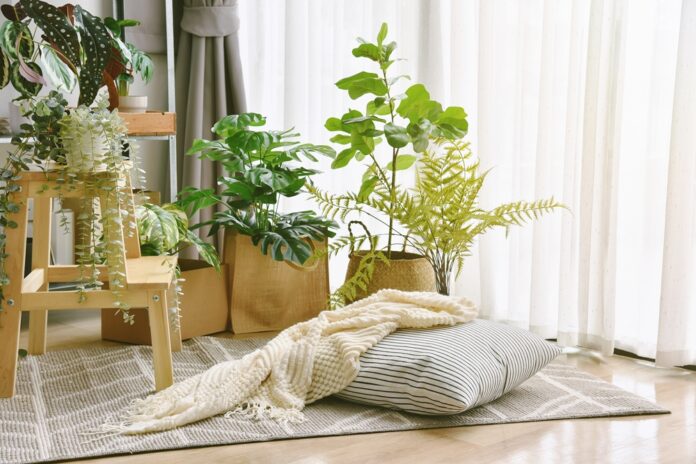In today’s world, creating a healthy and aesthetically pleasing indoor environment is more important than ever. Incorporating indoor plants not only enhances the visual appeal of our homes but also contributes to improving air quality. Certain plants are known for their ability to purify air by removing pollutants and toxins, making them excellent choices for indoor decoration.
Why Choose Air-Purifying Plants?
Indoor air can often contain pollutants such as formaldehyde, benzene, and trichloroethylene, which are emitted from common household items like furniture, carpets, and paints. Plants naturally filter air through processes like photosynthesis and transpiration, effectively removing these pollutants and contributing to healthier indoor environments. Moreover, plants can regulate humidity and provide psychological benefits, all while requiring minimal ongoing costs after the initial purchase.
Top Air-Purifying Plants for Your Home
Snake Plant (Sansevieria trifasciata)
The Snake Plant is renowned for its low maintenance and air purification abilities. Endorsed by NASA, this plant effectively removes toxins like formaldehyde and benzene from the air. Its sleek, upright leaves make it a stylish addition to any room, and it thrives in most light conditions, making it an ideal choice for busy individuals.
Endorsed by NASA, this plant effectively removes toxins like formaldehyde and benzene from the air.
Peace Lily (Spathiphyllum)
The Peace Lily is not only beautiful with its white blooms but also highly efficient at absorbing toxins through its leaves and breaking them down in the soil. It’s an excellent plant for improving indoor air quality and adds a touch of elegance to any space.
It’s highly efficient at absorbing toxins through its leaves and breaking them down in the soil.
English Ivy (Hedera helix)
English Ivy is effective in purifying air by reducing airborne fecal matter and absorbing chemicals from cleaning products. It’s also quite versatile and can be grown in hanging baskets or pots, making it suitable for various indoor settings.
Rubber Plant (Ficus elastica)
With its broad, glossy leaves, the Rubber Plant is excellent at removing pollutants from the indoor air. It is also a low-maintenance plant that can thrive in medium to bright indirect light, making it a great option for both homes and offices.
Rubber Plants are known for their easy maintenance and air-purifying properties.
Golden Pothos (Epipremnum aureum)
Also known as Devil’s Ivy, the Golden Pothos is a tough plant that can survive in low light and irregular watering. It’s particularly effective at removing volatile organic compounds (VOCs) like formaldehyde from the air.
Golden Pothos is known for purifying VOCs and requires minimal care.
Boston Fern (Nephrolepis exaltata)
The Boston Fern acts as a natural humidifier and is adept at restoring moisture to the air, which can be beneficial in dry indoor environments. It’s also efficient at removing pollutants such as formaldehyde and xylene.
The Boston Fern acts as a humidifier to restore moisture and improve air quality.
Spider Plant (Chlorophytum comosum)
Spider Plants are easy to grow and are excellent at removing carbon monoxide and other toxins from the air. They are ideal for individuals with busy lifestyles due to their low maintenance needs.
Aloe Vera
Aloe Vera is not only a healing plant but also releases oxygen and absorbs carbon dioxide at night, helping to purify the air while you sleep. It’s a succulent that requires minimal watering and maintenance.
Kentia Palm (Howea forsteriana)
The Kentia Palm is celebrated for its minimal maintenance needs and ability to enhance home aesthetics while improving air quality. It thrives in low to bright indirect light and adds a tropical feel to indoor spaces.
Incorporating Plants into Your Home
Selecting the right plants depends on various factors such as the size of your room, the amount of natural light, and whether you have pets. Many air-purifying plants are also pet-friendly, but it’s essential to check, as some can be toxic if ingested by pets.
For optimal air purification, it’s recommended to have at least two or three houseplants in 20 to 10-inch pots for every 9 square meters of indoor space. Regular maintenance, like wiping dusty leaves with a damp cloth, will ensure that your plants remain healthy and effective at purifying the air.
Combining Plants with Air Purifiers
While plants significantly improve air quality, they have limitations in removing high concentrations of pollutants or particulates. To achieve optimal indoor air quality, integrating plants with air purifiers can be highly effective. Air purifiers can rapidly improve air quality by filtering airborne particles, odors, and volatile organic compounds (VOCs).
For optimal indoor air quality, integrating both plants and air purifiers is suggested.
Final Thoughts
Incorporating air-purifying plants into your indoor spaces is a natural and cost-effective way to enhance air quality and beautify your home. With the variety of plants available, you can choose those that best suit your environment and personal preferences.
Note: The article is created strictly using the data provided, with links inserted as per the instructions.


